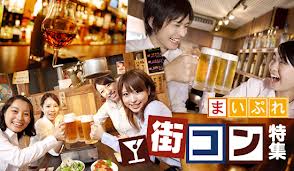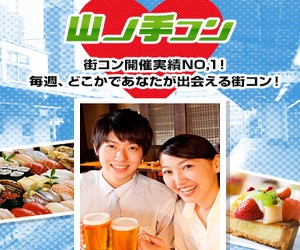Machikon: Revitalizing Local Economies and Raising the Birth Rate in Japan
CONTENTS
What is "gokon"?
By Ryoji Shimada, staff writer
“I haven’t had a chance to meet a romantic partner since I started to work full-time,” is a common complaint heard from young businesspeople. They try friends’ introductions, social events and gatherings, parties, various online and offline match-making services, social-networking services and so on. They use many different methods to meet prospective partners. The situation may be similar among young people in other countries. But nowadays in Japan another option has been added to the list and become quite common. Machikons have become popular all over the country. What is a machikon and why is it so popular?

The name of this new social event comes from “machi” (town) and “gokon” (mixer). The main difference between a machikon and a gokon is the size. There are at least 100 participants at a machikon, and sometimes as many as 3,000. They usually take part in pairs of the same sex. They move around the event venue, meeting and talking with other participants of the opposite sex. The venue comprises several restaurants and the system may be all-you-can-eat/drink, or tickets may be provided to be exchanged for food and drinks.
Because of its sheer size, a machikon doesn’t just facilitate encounters. It is also expected to revitalize local economies which are otherwise doomed due to the decreasing population and the continued aging of the communities.
Case Report

Shigeru Mihara, 36, lives in Osaka Prefecture. In March of this year he attended a machikon in Kyoto and another in Osaka with his friend Tetsuro Mori, 35. The one in Osaka, called the Chaya Machikon, was held on a Sunday afternoon in the Chaya-machi entertainment district near Umeda station, the biggest terminal station in Osaka. There were about 300 participants, and four restaurants were involved as venues. Both men had paid the 5,500 yen fee in advance by bank transfer. At the check-in desk set up inside one of the restaurants, they received a map showing where the restaurants were located, along with four drink tickets. Each time participants order a drink, they give a ticket to the server. This means that, for this three-hour machikon, participants can have four drinks of their choice. For those who want to drink more, an extra drink ticket costs 500 yen. According to the staff, this will prevent overdrinking and leftovers. But Mihara and Mori were given two tickets by female participants who couldn’t drink anymore. Four drinks are too much for some people.
The four restaurants were located close together. After checking in, Mihara and Mori were told to sit at any table in the restaurant they were already in. All the tables were set for four. They found an empty table near the entrance and sat side by side waiting for a female pair to take the seats across from them. They were a little worried that nobody would join them. At other tables, one by one, groups of four were forming.
The difficulties for a machikon organizer

This is the most mind-boggling element for the organizers. Balancing the number of male and female participants is always a major concern. The participation fee must be paid in advance, but they don’t expect everyone to show up. There are always cancellations, as well as some late arrivals.
“That’s always a big issue for us to deal with. If either gender of participants is lopsided, it causes complaints and dissatisfaction among participants,” said the staff of Chaya Machikon. If there is an imbalance, the staff arranges a group of six or eight instead.
Fortunately a female pair came to sit at Mihara and Mori’s table. At 1:15 pm, the machikon started with a toast. “Kanpai!” Then the staff explained how the party would function. Every hour, participants were to change tables or go to a different restaurant. They could choose which table or restaurant they want to go to. The food was preordered, so they had only to choose their drinks.
The two women at Mihara and Mori’s table worked at the same bank. They had a “senpai-kohai” (senior-junior) relationship. Mihara noticed this from the way they talked with each other. In Japan, junior staff use polite language when they speak with a more senior coworker. Like Mihara and Mori, the two women were attending a machikon for the first time. They talked about a variety of things, but the conversation was rather one-sided, with the men doing most of the talking and the women mainly listening.
The age gap is always an issue
The chemistry wasn’t very good. Mori commented later, “They were probably too young – maybe about 24 or 25? We’re in our mid-30s.” Age difference is always a big obstacle.

A machikon has usually an age limit. Participants should be between 20 and 40, but this range is really too wide. After all, it is rare for a 20-year-old man to be interested in a 40-year-old woman and vice-versa. So some organizations narrow the age range and host a machikon limited to people in their 20s or 30s, for example.
After a rather fruitless first hour at Mihara’s table, the staff announced that it was time to change tables. At this signal, Mihara and Mori exchanged a few polite words of appreciation with their female counterparts and left for another restaurant.
They chose an American-style restaurant for the second round, just a one-minute walk from the first one. They sat at a vacant table and waited. Soon a new female pair sat in front of them. They looked young too, but older than the first pair. After the first round there was no toast, but this time the female pair was more eloquent and the conversation more mutual. The two women lived in the same neighborhood, but they had different jobs. One was an office worker at a trading company and the other was a nursery school teacher. After an enjoyable conversation they exchanged contact information, then split up and moved on to the third round.
Exchanging contact information is tricky. If they fail to do so, they probably wouldn’t be able to meet again. On the map, this advice is written: “Don’t miss the chance to exchange contact information.” But of course, it is up to participants whether they want to share their personal information.
For the third and final one-hour round, the two men chose an Italian-style casual restaurant. This time, the staff directed them to the only table with vacant seats, where a female pair was already seated. Both women worked at the same hospital - one as a nurse, the other in management. By their appearance, Mihara and Mori guessed that they were in their 30s. It is common to ask someone’s age in Japan, but still impolite to ask straight away. The conversation went even better this time. They didn’t make an arrangement to meet again, but Mori suggested exchanging contact information.
5,500 yen for 3-hour drinking and eating

At 4 pm, their first machikon was over. Mori said with a smile, “Except for the first pair, I could get all the women’s contact information.” Mihara also enjoyed it, although he thought the fee was a bit expensive. But Mori said, “5,500 yen was quite reasonable. Most of the time, if you eat and drink for three hours, it often costs more than that.”
Mihara and Mori tried another machikon. This time it was in Kyoto, a prefecture adjacent to Osaka - and an ancient capital. The women in Kyoto are said to be snobbish and patronizing. It was going to be a tough challenge. The machikon was held on a Saturday night between 6 and 10 pm and spread over five restaurants. The number of participants was almost the same as in Osaka, about 300, but the system was slightly different. Instead of every hour, the pairs changed every 30 minutes. Interestingly, the male pairs didn’t move – only the female pairs did. According to the organizer, there had been some complaints by males that moving around the venues was troublesome. Another unique element was that the organizers provided sheets of paper where participants could write their contact information, making it easier to share. And there were no drink tickets – it was all-you-can-drink style with preset dishes. With the female pairs changing tables every 30 minutes, Mihara and Mori could meet 16 women over the course of four hours. Some were in their early 20s, some in their 30s, and others were even older.

Mihara commented afterwards, “It was a bit tiring. I could hardly remember the first pair.” Mori agreed and said, “Every round, empty glasses and used chopsticks were piled up on the table by the time the pairs changed. We were busy tidying up the table for the next pair.” They were also busy writing up their contact information on the sheet provided. But Mori said, “I’m not sure that they would ever call or send me an email.” Mihara also was pessimistic, saying, “They probably wouldn’t contact me.” There was one woman in her late 30s who asked Mori to have a drink some time, but even she didn’t contact him in the end. It seems important that the men get the women’s information and contact them first. And after the party had ended, some groups were exchanging contact information on their cell phones outside the venue.
According to an online poll conducted by the free magazine R25, 64% of people are satisfied with their machikon experience. But the other third are disappointed. The reasons vary. The most common response is “I didn’t meet anyone I was interested in,” followed by “we couldn’t talk calmly,” “imbalance of the number of male and female participants,” “I’m tired of same kind of questions and conversations,” and other more detailed comments.
The Japan Machikon Producer’s Organization advises participants, “For Machikon beginners, it is better to participate in small-scale event, rather than a big one with over 1,000 people, so that they can move smoothly between the restaurants. Also, it is recommended to attend a machikon which has a good reputation and a long history.”
Boosting the Birthrate and the Economy?
What about the result? Organizers don’t follow up with each participant, so there are no official statistics. But in Mihara and Mori’s case, Mori met one female participant two weeks later and he was seriously thinking of becoming a couple with her. One of the biggest machikons, the Miyakon in Utsunomiya, Tochigi Prefecture, is reported to produce many married couples. So it will certainly help change the stagnant birthrate.
How about the original purpose - propping up sluggish local economies? Eiichi Sato, mayor of Utsunomiya City, voiced his hope of revitalizing the local economy and utilizing restaurants’ slow periods. Nowadays many machikons are co-organized by local chambers of commerce and their expectations are high. One restaurant manager in Kyoto said, “We are happy to provide a venue for a machikon here at times when we don’t usually have many customers, such as early Saturday evenings or on Sundays.” For restaurant owners, having a machikon is like having a very big group reservation. And it’s even better if they have a big group of customers during a slow period.
Nagoya Mayor Takashi Kawamura himself participated in one of the biggest machikons in Nagoya two years ago and said firmly, “The Nagoya municipal government would like to support this kind of event wholeheartedly. I want to liven up both the economy and the young people!”
The history and development of the machikon
According to Nihon Machikon Kyokai (the Japan Machikon Association), the first machikon was held in Utsunomiya, Tochigi Prefecture, in 2004. It was originally intended to revitalize the local economy, especially the commercial district. In 2011, the boom started to spread to other regions and now more than 1,000 machikons are held around the country every year. Another association, the Japan Machikon Producer’s Organization points out another benefit. It will solve problems such the high rate of unmarried people and the declining population. It says the machikon is a significant event that will kill several birds with one stone.
Now, various forms of machikons are being developed. A “mall-kon” is characterized by its venue – an entire shopping mall, while a “sora-kon” is an overnight trip using an airplane and the restaurants at an airport as its venue. (Sora means sky.)
Alcohol is usually served, so participants are required to be over the age of 20. They sometimes have an upper limit, such as 40 or 45. The participation fee is usually between 4,000 and 10,000 yen which normally includes food and beverages. The fee for men is generally little more expensive - about 1,000 yen - than for women.


